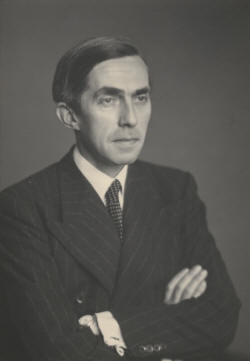

Queer Places:
University of Oxford, Oxford, Oxfordshire OX1 3PA
University of Cambridge, 4 Mill Ln, Cambridge CB2 1RZ
 Sir Henry Roy Forbes Harrod (13 February 1900 – 8 March 1978) was an English economist. He is best known for writing The Life of
John Maynard Keynes (1951) and for the development of the Harrod–Domar model, which he and Evsey Domar developed independently. He is also known for his International Economics, a former standard textbook, the first edition of which contained some observations and ruminations (wanting in subsequent editions) that would foreshadow theories developed independently by later scholars (such as the Balassa–Samuelson effect).
Sir Henry Roy Forbes Harrod (13 February 1900 – 8 March 1978) was an English economist. He is best known for writing The Life of
John Maynard Keynes (1951) and for the development of the Harrod–Domar model, which he and Evsey Domar developed independently. He is also known for his International Economics, a former standard textbook, the first edition of which contained some observations and ruminations (wanting in subsequent editions) that would foreshadow theories developed independently by later scholars (such as the Balassa–Samuelson effect).
Born in London[1] he attended St Paul's and then Westminster School. Harrod attended New College in Oxford on a history scholarship. After a brief period in the Artillery in 1918 he gained a first in "literae humaniores" in 1921, and a first in modern history the following year. Afterwards he spent some time in 1922 at King's College, Cambridge. It was there that he met and befriended Keynes.[2] After moving back to Oxford, he became a Student (i.e., Fellow) and Tutor in economics at Christ Church. He held the fellowship in modern history and economics until 1967. He remained in contact with Keynes until Keynes's death in 1946, and was later his biographer (1951). Harrod was additionally a Fellow at Nuffield College 1938 to 1947 and from 1954 to 1958. At Oxford John Sutro conceived the Railway Club, which was dominated by Harold Acton. The other members included: Henry Yorke, Roy Harrod, Henry Thynne, 6th Marquess of Bath, David Plunket Greene, Edward Henry Charles James Fox-Strangways, 7th Earl of Ilchester, Brian Howard, Michael Parsons, 6th Earl of Rosse, John Sutro, Hugh Lygon, Harold Acton, Bryan Guinness, 2nd Baron Moyne, Patrick Balfour, 3rd Baron Kinross, Mark Ogilvie-Grant, John Drury-Lowe.[3]
During the Second World War, he was briefly in Winston Churchill's "S-branch" – a statistical section within the Admiralty. At the 1945 General Election he stood as Liberal candidate for Huddersfield and finished third. In 1966, Harrod, was the 2nd winner of the prestigious Bernhard-Harms-Preis.[4] After retiring in 1967, he moved to Holt, Norfolk. Interviewed for the book Authors take Sides on Vietnam, Harrod declared himself a supporter of the American military campaign in Indochina.[5] Assar Lindbeck, the former chairman of the Nobel Prize Committee, wrote that Harrod would have been awarded a Nobel Memorial Prize in Economic Sciences if he had lived longer. Harrod married Wilhelmine "Billa" Cresswell (1911–2005), step-daughter of General Sir Peter Strickland, in 1938.[6] One of their sons was Dominick Harrod, an economics correspondent for the BBC.[7]

Railway Club at Oxford, conceived by John Sutro, dominated by Harold Acton. (Left to right) Back: Henry Yorke, Roy Harrod, Henry Weymouth, David Plunket Greene, Harry Stavordale, Brian Howard. Middle row: Michael Rosse, John Sutro, Hugh Lygon, Harold Acton, Bryan Guinness, Patrick Balfour, Mark Ogilvie-Grant, Johnny Drury-Lowe. Front: porters.
My published books: